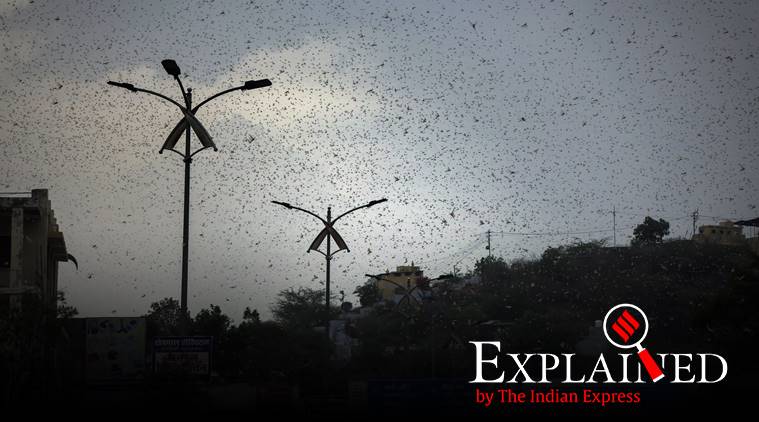- India
- International
Locust attack: A joint fight by India and Pakistan, over the years
Despite the ups and downs in the India-Pakistan bilateral relationship, cooperation on the locust warning system has survived the wars, terrorist attacks, and political turmoil.
 Locusts swarm over Ajmer, Rajasthan. (AP Photo: Deepak Sharma)
Locusts swarm over Ajmer, Rajasthan. (AP Photo: Deepak Sharma)
In 1993, as swarms of locusts started coming into Jaisalmer, Anil Sharma, a locust warning officer, was asked by a senior official, “How locust can come to India when we have fencing on the (India-Pakistan) border?” Sharma politely replied that locust is an insect and knows no barriers.
As another locust swarm comes from Pakistan, the spotlight is again on the India-Pakistan dynamic that has come into play. The Ministry of External Affairs says it has reached out to Pakistan for cooperation, and is awaiting their response. Despite the ups and downs in the bilateral relationship, cooperation on the locust warning system has survived the wars, terrorist attacks, and political turmoil.
History of outbreaks
While legend has it that locusts were part of the Mahabharata during Karna’s battle with Arjuna, modern-day records suggest that since the beginning of the 19th century, there have been at least eight “outbreaks” in India from 1812 to 1889, and a ninth in 1896-1897.
According to history of the Locust Warning Office published by the UN Food and Agriculture Organization (FAO), there were “serious invasions” of locusts in India every few years during the 1900s. A “five-year invasion” from 1926 to 1931 is estimated to have to have damaged crops worth Rs 2 crore (about $100 million at today’s prices).
Also read | Locust attack: How they arrived, the seriousness of the problem, and ways to solve it

The princely states and provinces had their own structures to deal with this, but there was no coordination. After the 1926-32 “invasion”, the British Indian government sponsored a research scheme, starting 1931, which led to the permanent Locust Warning Organization (LWO) in 1939, with its headquarters in New Delhi and a substation in Karachi.
In 1941, a conference of princely states in desert areas and provinces affected by locusts was held. Its role was expanded in 1942, and in 1946 a bureaucratic structure was put in place.
Beginning of cooperation
Iran too suffered locust attacks, in 1876, and in 1926-1932. “Apparently the first case of collaboration between countries in the region occurred in 1942 when a delegation from India helped with locust control work in southwest Persia. Over the next two years, Indian help was also provided to Oman and Persia. This was followed by the first conference within the region on Desert Locust, which was held in Tehran in 1945 and involved Iran, India, Saudi Arabia and Egypt… A second conference took place in 1950 also in Tehran with Pakistan participating,” the FAO says.
In the 1950s, India and Iran cooperated and Pakistan provided two aircraft for locust surveys in Saudi Arabia. Following another attack during 1958-61, a decision was taken to group Iran, Afghanistan, Pakistan and India together and the FAO Desert Locust commission was formed in 1964. The commission held annual sessions, skipped in 1965 and 1999 but held in 1971. Even in the last six years when the relationship between India and Pakistan has deteriorated, it has been held in 2014, 2016 and 2018.
The meetings are attended by locust control experts, with no diplomats.
📣 Express Explained is now on Telegram. Click here to join our channel (@ieexplained) and stay updated with the latest
India and Pakistan
In 1977, the two countries began to meet on the border. From 1991 to 2003, special border surveys took place during the summer, undertaken by locust control officers in their respective countries.
Joint border meetings have taken place every year since 2005 till 2019, except in 2011. This has been despite every diplomatic strain, including the 26/11 Mumbai attacks.
 A huge tropical locust swarm in Jaipur on Monday. (Express Photo: Rohit Jain Paras)
A huge tropical locust swarm in Jaipur on Monday. (Express Photo: Rohit Jain Paras)
Monthly meetings are held between June and October-November at Zero Point, west of Barmer, Rajasthan and east of Chor, Tharparkar. Three to four officers from each country normally attend. Each country takes turns at hosting the meeting on its respective side of the border.
Arrangements are made in advance and protocols are followed for crossing the border. The meeting is held in the morning. “Fortnightly bulletins, FAO bulletins and maps showing survey locations, locust infestations, green vegetation and rainfall in each country are exchanged and discussed,” the report on their activities said.
While politics and diplomacy is kept out of the technical discussions, locust control authorities feel that one of the more difficult challenges faced by the commission is that of “insecurity and sensitivities” in the region.
More Explained
EXPRESS OPINION
Apr 19: Latest News
- 01
- 02
- 03
- 04
- 05








































